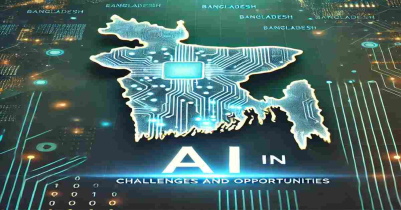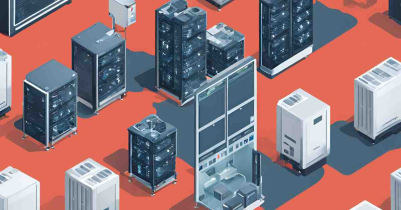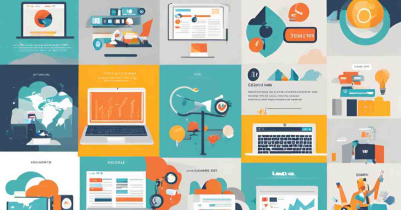Eye News Desk
Exploring the future of AI

In today's world, technology has become an integral part of our lives, transforming how we live, work, and communicate. From smartphones to social media, technology has revolutionized the way we interact with the world around us, making our lives easier, more efficient, and more connected than ever before. Automation has given us more time than ever before to pursue our hobbies and interests.
Despite not always feeling like it, we have more free time now than ever before, allowing individuals more leisure time to socialize, create, and unwind. In recent years, the advancement of automation has been largely driven by the emergence of artificial intelligence (AI). The rise of AI has led to significant improvements in efficiency and productivity across various industries. With the ability to automate mundane tasks that people would rather not do, AI has become an increasingly popular tool for people around the world.
Rapid developments in recent years can be attributed to the widening range of possible uses for AI in fields like health care and transportation. In recent years, there has been a great deal of interest in the field of AI. However, people's views on AI differ according to their familiarity and knowledge. In this article, we will examine how different people's familiarity with AI leads to varying interpretations of this field. This article compares and contrasts popular beliefs about AI with the truth about this emerging technology. The future of AI in the workplace is also discussed, along with its potential in Bangladesh.
Perception vs reality
AI is a tool that has the potential to enhance human capabilities and boost productivity. AI is a term used to describe the ability of a computer system to perform tasks that typically require human intelligence. These tasks can include decision-making, problem-solving, and learning new information. AI relies on various techniques, such as machine learning methods, neural networks, and natural language processing, to analyze data and generate predictions.
AI is often associated with negative connotations due to its portrayal in science fiction movies where robots or AI are depicted as antagonists. If the general public had the impression that the technology was unreliable, they would be less inclined to trust it.
AI's future is a mystery. “One can imagine such technology outsmarting financial markets, out-inventing human researchers, out-manipulating human leaders, and developing weapons we cannot even understand,” stated renowned scientist Stephen Hawking. Is robot control a real threat? How much should we worry?
AI and other developing technologies are here, but they're still being developed, and no one -- not even experts -- knows their future. As smarter AI is developed, it's crucial to realistically assess its risks and benefits. Let's examine many prevalent AI danger beliefs and see if they're accurate.
- Robots will rule
- The idea dates from 1965 through 2023 to 2045. We're not there yet. AI has been used in a narrow range so far, and while we'll continue to improve technology, robots taking over in 50 years seem doubtful. The New York Times states: “You won't be obsolete for a long time, if ever”
- We'll be replaced by robots
- AI will change work. How firms and governments react to AI's growing ability to manage human occupations will determine the impact. Two-thirds of Americans expect robots to do most human work in 50 years, according to Pew Research. But technology's expected impact on jobs is different, comparing studies on how many jobs technology will kill (and create) shows that no one knows. Technology Review states: “Predictions range from optimistic to devastating, differing by tens of millions of jobs even when comparing similar time frames.” According to Gartner, AI will eliminate 1.8 million jobs by 2020 but create 2.3 million
- AI will invade privacy and cause persistent surveillance
- Video algorithms can detect and track humans and objects. Google, MIT, IBM, and DeepMind are constructing video databases for facial recognition and behavior analysis. Current AI technology can replicate human voice and alter video with outcomes indistinguishable from real life, threatening privacy, safety, and honest news reporting.
- AI is great at spying and invading personal data, but scientists argue computers can't understand media like humans. We're getting closer to programmes that can watch and participate in surveillance and data systems. These technologies are value neutral, thus how they are used is a human issue.
AI technology can be scary, yet it's easy to trust sophisticated tech that can surpass human abilities. Better tech that solves human problems requires transparency.
The impact of AI on the work domain
One of the fastest-growing industries today is AI. The ultimate goal of this field is to create systems as sophisticated as the human brain. There have been numerous attempts at creating AI that can learn, understand, and function similarly to human beings and human brains.
When we consider the problems AI is currently resolving, we may assume that it is a brand new field, although McCarthy first introduced the term "AI" to the world during the 1956 Dartmouth conference. Grand View Research estimates that between 2022 and 2030, the global market for AI would increase from its current value of $93.5 billion at a CAGR (compound annual growth rate) of 38.1%. Constant study in the field is improving the operational nature of all critical areas of the business. Let's explore areas where the application of AI is experiencing tremendous growth.
- Financial Services: AI was early adopted in this industry. Data and difficult use cases are the reasons. The history of banking and finance shows that this sector is vital to human development and takes a lot of effort to avoid fraud and failure. Avoiding this requires a well-trained computer, AI algorithms and initiatives to protect the system and generate big profits. Chatbots and personalized investment advisors are offered by several banks recommending the finest services and goods, several recommendation systems are used. Designing digital payment channels with AI agents
- Health care: AI has a big impact on health care. We can see that AI is used in various kinds of health care procedures, from daily ones to high-level ones that require accuracy. The fit band or iWatch, which collects data from body sensors, is a simple example of AI in health care. The artificially intelligent agent provides information regarding heart rate, water needs, and data steps. Abnormal bodily effects can also be reported. In recent years, AI has been used to create Covid-19 medications. Every major pharmaceutical business uses AI for drug discovery, robotic surgeries, virtual nursing assistants, and chatbots
- Education: AI has expanded education's potential. AI can grade instructional content faster and easier than humans. AI may also automate processes, personalize learning, universally access, create smart content, teach, optimize class performance, and provide 24/7 assistance. Online classes are one of the best instances of AI in education. Teachers can now monitor kids' academic, psychological, mental, and physical well-being for holistic growth
- E-Commerce: AI works well in e-commerce. AI currently attracts and boards customers safely through E-commerce. AI can forecast demand and supply, assist customers, recommend products, personalize chatbots, and more in e-commerce. Amazon, the largest e-commerce site, develops AI to stay profitable. Their high-end recommendation system attracts clients and 24X7 AI-enabled assistance manages customer requests and complaints to improve user experience
- Agriculture: AI is now employed for crop monitoring, predictive analysis, and robot tasking in agriculture. Soil, seed, and atmospheric characteristics are measured using various systems. Drones can distribute water, fertilizer, and detect crop defects using AI
- Mechanics: By the end of the 21st century, all major manufacturers used AI in their factories and other activities. Automobiles employ AI in manufacturing products, Tesla cars use self-driving and sleep detection technology. Robots trained to maintain and repair cars and manufacturing equipment can be found inside and outside autos. Besides industrial systems, AI is replacing mechanical components like pressure detectors, vernier scales, gauges, etc. AI dependability is growing in this industry
- Entertainment: The popularity of the internet and media has contributed to the development of AI. AI is used by YouTube, Netflix, Amazon Prime Video, and Hotstar. These services now recommend films to users depending on their preferences. The platform's recommendation systems use user demographics to predict our interests
- Space Research: The use of AI has allowed explorers of the cosmos to reach previously inaccessible heights. AI has been used by NASA, SpaceX and ISRO for space exploration. Mars rovers were successful, thanks to AI. Scientists were aided in their search for new planets and stars because of this project. The entire field of space exploration relies on AI for hands-free data collection, analysis, and reporting
AI is improving every field daily. As we mentioned the market potential, every organization would invest time and money in the industry to improve their work and earnings.
Getting ready for the next generation of AI
It is vital for both organizations and individuals to make preparations for the changes that will be brought about by AI, as the importance of AI continues to grow. To get ready for the arrival of AI in the near future, the following are some preparations that can be taken:
Developing skills in AI As AI grows more widespread in the workplace, there will be an increased demand for people who are skilled in data analysis, machine learning, and programming. In order to maintain a competitive edge in the employment market, it is necessary to acquire these abilities.
Placing an emphasis on creative thinking and emotional intelligence: As was said previously, AI is unable to reproduce the abilities associated with creative thinking and emotional intelligence. To complement AI and maintain a competitive edge in the workplace, it is imperative to place a strong emphasis on the development of these talents.
Investing in AI Research: Both private companies and public administrations need to put money into AI research if they want to remain at the forefront of AI development and adoption. In order to accomplish this, investments will need to be made in AI startup companies, research institutions, and cooperation with other nations.
Developing Ethical and Legal Frameworks: As AI becomes more pervasive in society, there is a need to build ethical and legal frameworks to guide the development and use of the technology. These frameworks will help ensure that AI is used in a responsible manner. In order to accomplish this, regulations for the creation and use of AI will need to be devised, and it will also be necessary to ensure that AI is developed in a responsible and ethical manner.
ChatGPT and its future
The use of chatbots by businesses to communicate with their customers has increased dramatically in recent years. One such chatbot, ChatGPT, was developed by OpenAI, a leading AI research institution. Using natural language processing, ChatGPT may provide responses to text inputs that sound disturbingly human. Future uses of ChatGPT, its operational area, how to make the most of it, its accuracy, and the hazards associated with employing it will all be discussed here.
As AI development progresses, the number of scenarios in which ChatGPT could be used will grow and many industries can benefit from it, including teaching, medicine, and customer service. On top of that, it can be used to create individualized recommendations for clients based on their interests and past activities. As time goes on and technology improves, it's likely that ChatGPT will become even more sophisticated, allowing it to take on more challenging tasks.
Textual communication predominates in the realm of extension and operations for ChatGPT. Thanks to its modular design, the product works with numerous messaging apps. These include Facebook Messenger, Slack, and Telegram. Using ChatGPT, you can provide assistance, address frequently asked questions, and carry on discussions with clients across many channels. The speech-generating models developed by OpenAI have made it possible to integrate ChatGPT with other voice-based communication methods in addition to text. The availability of speech-generating models paved the way for this.
A GPT Tutorial Getting the most out of ChatGPT requires a thorough understanding of the platform's limitations. While ChatGPT can simulate human-sounding responses, it cannot truly understand human language. In order to ensure that ChatGPT can provide correct and relevant responses, it is necessary to have use cases that are explicitly stated, as well as training data. In addition, the system's performance can be improved through continual monitoring and the application of necessary tweaks.
OpenAI regularly releases updates to the model, which contribute to ChatGPT's ever increasing accuracy. But it has limitations and can make mistakes, the same as any other machine learning system. One of ChatGPT's limitations is how reliant it is on the quality of the training data provided. If the training data are biased or incomplete, the resulting answers may be inappropriate or incorrect. Therefore, it is crucial to curate and monitor the training data to ensure ChatGPT produces correct and ethical replies.
As with any other sort of AI technology, there are risks associated with employing ChatGPT. Prejudice and favoritism are a potential threat that should be taken seriously. If the data used for training ChatGPT is biased in any way, it could return inappropriate or discriminatory results. The service may also be exploited if someone uses ChatGPT to carry out illegal activities or spread false information, for example. As a result, stringent monitoring and regulation of ChatGPT use is required to lessen the risk of these dangers.
The potential for ChatGPT to transform the way humans interact with machines is enormous. Because of its ability to understand and respond to natural language, it can provide clients with fast, efficient, and personalized service. However, the limitations and risks associated with the technology must be carefully considered to ensure that it is used ethically and responsibly. ChatGPT has a wide variety of potential uses, and this set is only set to grow as technology develops and ChatGPT gains greater intelligence and the ability to tackle challenging jobs.
AI in Bangladesh
Bangladesh is still in the early stages of AI research, with only a handful of uses for the technology across a wide range of industries. However, businesses and the government are increasingly showing an interest in AI, and there are initiatives underway to increase AI use across the country.
AI is currently being used in many different sectors in Bangladesh, including agriculture, banking, and health care. Individualized treatment plans and better illness diagnostics are two areas where AI is being put to use in the medical industry. AI is being used to reduce fraud and enhance investment portfolios in the financial sector. AI is being used in the agriculture sector to improve crop yields and develop methods for precision farming.
Bangladesh is not as advanced in its AI preparations as more developed nations like the United States, Japan, or China. However, businesses and the government are increasingly showing an interest in AI, and there are initiatives underway to increase AI use across the country. The government of Bangladesh has established the Bangladesh High-Tech Park Authority and taken other measures to foster the growth of the country's technological sector.
In terms of AI implementation, Bangladesh lags far behind India. India has become a leading hub for AI thanks to its growing number of AI-related firms and active AI research community. The Indian government has also taken initiatives to expand the country's AI industry. The National AI Strategy was released as one of these measures, with the aim of standardizing the growth and application of AI across sectors.
Read More
- 32 megapixel camera new phone Tecno Spark 10 Pro
- Google Bard now in Bangladesh
- AI in Bangladesh: Unlocking Potential Amid Challenges
- Refreshing only increases the speed of the computer?
- Samsung Galaxy A54 5G: A perfect price fit!
- Elon Musk`s SpaceX hires 14-year-old Bangladeshi-American Kairan
- Tottering from Twitter to Threads
- Spotify tests voice translation feature for podcasts
- How Afraid Should We Be of Artificial Intelligence?
- The Godfather of AI quits Google; warns of impending danger
































